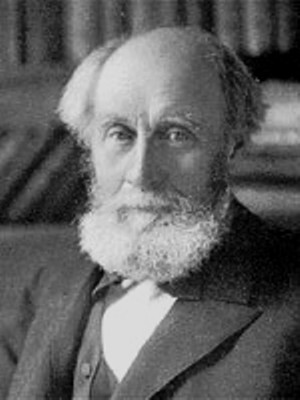<Back to Index>
- Geologist John William Dawson, 1820
- Composer Anselm Hüttenbrenner, 1794
- Leader of the Social Democratic Party of Germany Kurt Schumacher, 1895
PAGE SPONSOR

Sir John William Dawson, CMG, FRS, FRSC (October 13, 1820 – November 19, 1899), was a Canadian geologist and university administrator.
John William Dawson was born in Pictou, Nova Scotia, where he attended and graduated from Pictou Academy. Of Scottish descent, Dawson attended the University of Edinburgh to complete his education, and graduated in 1842, having gained a knowledge of geology and natural history from Robert Jameson.
Dawson returned to Nova Scotia in 1842, accompanying Sir Charles Lyell on his first visit to that territory. Dawson was subsequently appointed as Nova Scotia's first superintendent of education. Holding the post from 1850 to 1853, he was an energetic reformer of school design, teacher education and curriculum. Influenced by the American educator Henry Barnard, Dawson published a pamphlet entitled, "School Architecture; abridged from Barnard's School Architecture" in 1850. One of the many schools built to his design, the Mount Hanley Schoolhouse still survives today, including the "Dawson Desks" named after him. Dawson's travels as school superintendent allowed him to deepen his geological studies, as he visited and studied geological sites across the region. He entered zealously into the geology of Canada, making a special study of the fossil forests of the coal - measures. From these strata, in company with Lyell (during his second visit) in 1852, he obtained the first remains of an air breathing reptile named Dendrerpeton.
From 1855 to 1893 he was professor of geology and principal of McGill University in Montreal, an institution which under his influence attained a high reputation. In 1859 he published a seminal paper describing the first fossil plant found in rocks of Devonian origin. Although his discovery did not have the impact which might have been expected at the time, he is now considered one of the founders of the science of palaeobotany. He later described the fossil plants of the Silurian, Devonian and Carboniferous rocks of Canada for the Geological Survey of Canada (1871 - 1873). He was elected FRS in 1862. When the Royal Society of Canada was created he was the first to occupy the presidential chair, and he also acted as president of the British Association at its meeting at Birmingham in 1886, and president of the American Association for the Advancement of Science. Sir William Dawson's name is especially associated with Eozoon canadense, which in 1865 he described as an organism having the structure of a foraminifer. It was found in the Laurentian rocks, regarded as the oldest known geological system. His views on the subject were contested at the time, and have since been disproven, the so-called organism being now regarded as a mineral structure. He was created CMG in 1881, and was knighted in 1884. In his books on geological subjects he maintained a distinctly theological attitude, declining to admit the descent or evolution of man from brute ancestors, and holding that the human species only made its appearance on this earth within quite recent times. In 1882, while looking to fill the vacancy left at McGill by the death of botanist James Barnston, Dawson contacted Asa Gray of Harvard University for recommendations. Gray suggested his former assistant David P. Penhallow, who Dawson accepted as a lecturer.
Besides many memoirs in the Transactions of learned societies, he published several books.
One of John's sons, George Mercer Dawson (1849 - 1901), became a well known and respected scientist and geologist in his own right.
He is interred in the Mount Royal Cemetery in Montreal, Quebec and is the namesake for Dawson College. The mineral Dawsonite, which was discovered during the building of the Redpath Museum with which he was intimately related, is named in his honour.